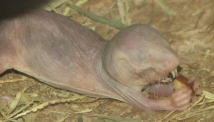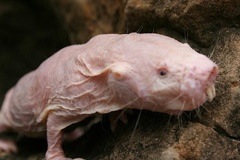Proposal to Sequence an Organism of Unique Interest for Research on Aging: Heterocephalus glaber, the Naked Mole-Rat
Important notice: The naked mole-rat genome has now been sequenced and is made available in our purpose-built portal. Therefore, the description of this project is outdated and kept here only as a record. This page will not be updated again, and may be deleted sometime in the future.
The purpose of this page is to summarize our efforts to sequence the genome of the naked mole-rat (Heterocephalus glaber), a unique organism for research on aging and age-related diseases. Heterocephalus has a record longevity of 28.3 years, which makes it the longest-lived rodent with a much longer lifespan than expected for its small body size (see Figure).
In 2007-2008, we gathered widespread support from the gerontological and Heterocephalus communities (79 scientists supported the proposal) and submitted a "white paper" genome sequencing proposal to the National Human Genome Research Institute (NHGRI, one of the institutes that makes up the NIH). Unfortunately, Heterocephalus was not given high priority for sequencing. Nonetheless, considering the dropping costs of sequencing, we are confident that sequencing Heterocephalus will be cost-effective in a near future. Below you can find further information about our efforts and the importance of sequencing the genome of Heterocephalus, as well as that of other long-lived species, for research on aging.
As further detailed in the proposal, Heterocephalus was chosen by also taking into consideration short-lived rodents already being sequenced that can be used in comparative studies of aging. Sequencing its genome will provide researchers with the necessary tools to help establish Heterocephalus as a unique long-lived model for biomedical research. It will greatly assist studies on the evolution of longevity and to understand the genetic and molecular mechanisms of aging with multiple potential applications for improving human health. |
 |
Coordinating this endeavor are Pedro Magalhães (contact information below), John Sedivy, Steven Austad, Tuck Finch, Shelley Buffenstein, and George Church.
Initially, our efforts also focused on the white-faced capuchin monkey (Cebus capucinus) which can live over 50 years, and the bowhead whale (Balaena mysticetus), the longest-lived mammal with an estimated longevity of over 200 years. Our initial proposal was rejected in 2007, however, and we decided to submit a revised version only featuring Heterocephalus. As sequencing costs decline, we expect Cebus, Balaena, and other organisms of interest for biogerontology to be the focus of further genome sequencing efforts.
All comments, suggestions, and ideas are of course welcome. Please feel free to contact us.
Downloads
Revised white paper proposal focusing on Heterocephalus glaber (submitted March 17, 2008). |
White paper proposal focusing on Heterocephalus glaber, Cebus capucinus, and Balaena mysticetus (submitted May 15, 2007). |
Short paper describing our efforts (published in the Journal of Gerontology: Biological Sciences in 2007). |
Summary
Aging is not only a major puzzle of biology but it has a profound impact on medicine with age-related diseases like heart diseases, type II diabetes, cancer, and neurodegenerative diseases among the leading causes of death in modern societies. Recent research has revealed several gene systems that can regulate longevity in model organisms and appear evolutionary conserved. Nonetheless, the longevity effects of these genes are modest when compared to the lengthening of lifespans during evolution. Among mammals there is at least a 40-fold variation in maximum longevity. We still do not know why different species of similar body plan, biochemistry, and physiology can age at such different rates, but these differences must be seated in the genome.
In this white paper, we propose the genome sequencing of a unique long-lived organism, the naked mole-rat (Heterocephalus glaber). Heterocephalus has a record longevity of 28.3 years which makes it the longest-lived rodent with a much longer lifespan than expected for its relatively small body size. Because Heterocephalus can live remarkably longer than similar-sized rodents, such as mice and rats that can only live up to 4-5 years, it can be used as a model of resistance to disease and, in fact, Heterocephalus is extremely resistant to neoplasia. Therefore, sequencing its genome will provide the sophisticated molecular biology tools necessary for Heterocephalus to be used not only as another model of human biology but primarily as the first model of resistance to chronic diseases of aging.
Because Heterocephalus was chosen to dovetail with existing mammalian sequencing projects, studies in Heterocephalus can be conducted in parallel in closely-related short-lived species to test hypotheses of aging. Researchers will thus be able to study mechanisms and genes previously associated with aging using a unique comparative approach. Such studies will increase our understanding of the evolution of longevity as well as of the molecular, cellular, and genetic mechanisms of aging. Moreover, insights obtained in Heterocephalus will drive experiments in more traditional models, in particular by taking advantage of the mouse as a surrogate system to study the Heterocephalus genome.
Overall, sequencing the Heterocephalus genome will help establish this organism as the first long-lived model for biomedical research. If we could understand the molecular and genetic basis of differences in aging between mammals, it would open a new paradigm for biomedical research on aging and age-related diseases with countless potential applications for improving human health. In addition to its utility as a model to study the molecular and genetic mechanisms of aging, Heterocephalus has other fascinating evolutionary adaptations, such as being virtually poikilothermic which makes it a unique model to study mammalian metabolic regulation. Heterocephalus also has a eusocial system that makes it exceptional in studies of growth, development, reproduction, and behavior.
The Longevity of Heterocephalus Compared to other Mammals

Plot of the relationship between ln-transformed maximum longevity and typical adult body mass for non-volant mammals (n = 820). Heterocephalus glaber (H. g.) is highlighted by a red square. H. s. = Homo sapiens (in blue). Data from build 9 of AnAge.
Proposal Article
To help circulate the proposal among biogerontologists, we also published a short article in the Journal of Gerontology: Biological Sciences briefly explaining the rationale behind this endeavor and its usefulness for understanding the biology of aging.
Some Useful Links
NHGRI - Instructions for Submitting a Proposal for the Sequencing of a New Target Genome
NHRGI - Sequencing Target Organism Selection Procedures
NHRGI - Genome Sequencing Proposals and Their Status
NHGRI's Vision for the Future of Genomics Research
International Sequencing Consortium - Sequencing Project Database
Contact Information
João Pedro de Magalhães
School of Biological Sciences
Biosciences Building, Room 245
University of Liverpool
Crown Street, Liverpool L69 7ZB
United Kingdom
Phone: +44 151-7954517
E-mail: aging#liv.ac.uk (# = @)

